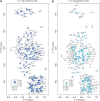Backbone NMR assignments of the extensive human and chicken TRPV4 N-terminal intrinsically disordered regions as important players in ion channel regulation
- PMID: 35451798
- PMCID: PMC9027025
- DOI: 10.1007/s12104-022-10080-9
Backbone NMR assignments of the extensive human and chicken TRPV4 N-terminal intrinsically disordered regions as important players in ion channel regulation
Abstract
Transient receptor potential (TRP) channels are important pharmacological targets due to their ability to act as sensory transducers on the organismic and cellular level, as polymodal signal integrators and because of their role in numerous diseases. However, a detailed molecular understanding of the structural dynamics of TRP channels and their integration into larger cellular signalling networks remains challenging, in part due to the systematic absence of highly dynamic regions pivotal for channel regulation from available structures. In human TRP vanilloid 4 (TRPV4), a ubiquitously expressed homotetrameric cation channel involved in temperature, osmo- and mechano-sensation and in a multitude of (patho)physiological processes, the intrinsically disordered N-terminus encompasses 150 amino acids and thus represents > 17% of the entire channel sequence. Its deletion renders the channel significantly less excitable to agonists supporting a crucial role in TRPV4 activation and regulation. For a structural understanding and a comparison of its properties across species, we determined the NMR backbone assignments of the human and chicken TRPV4 N-terminal IDRs.
Keywords: Intrinsically disordered protein; Ion channel; Regulatory domain; Structural dynamics; TRP vanilloid; Transient receptor potential.
© 2022. The Author(s).
Conflict of interest statement
The authors declare that they have no conflict of interest.
Figures



References
-
- Botte M, Ulrich AKC, Adaixo R, Gnutt D, Brockmann A, Bucher D, Chami M, Bocquet N, Ebbinghaus-Kintscher U, Puetter V, Becker A, Egner U, Stahlberg H, Hennig M, Holton SJ (2020) Cryo-EM structural studies of the agonist complexed human TRPV4 ion-channel reveals novel structural rearrangements resulting in an open-conformation. 10.1101/2020.10.13.334797. bioRxiv
Publication types
MeSH terms
Substances
LinkOut - more resources
Full Text Sources
Molecular Biology Databases

